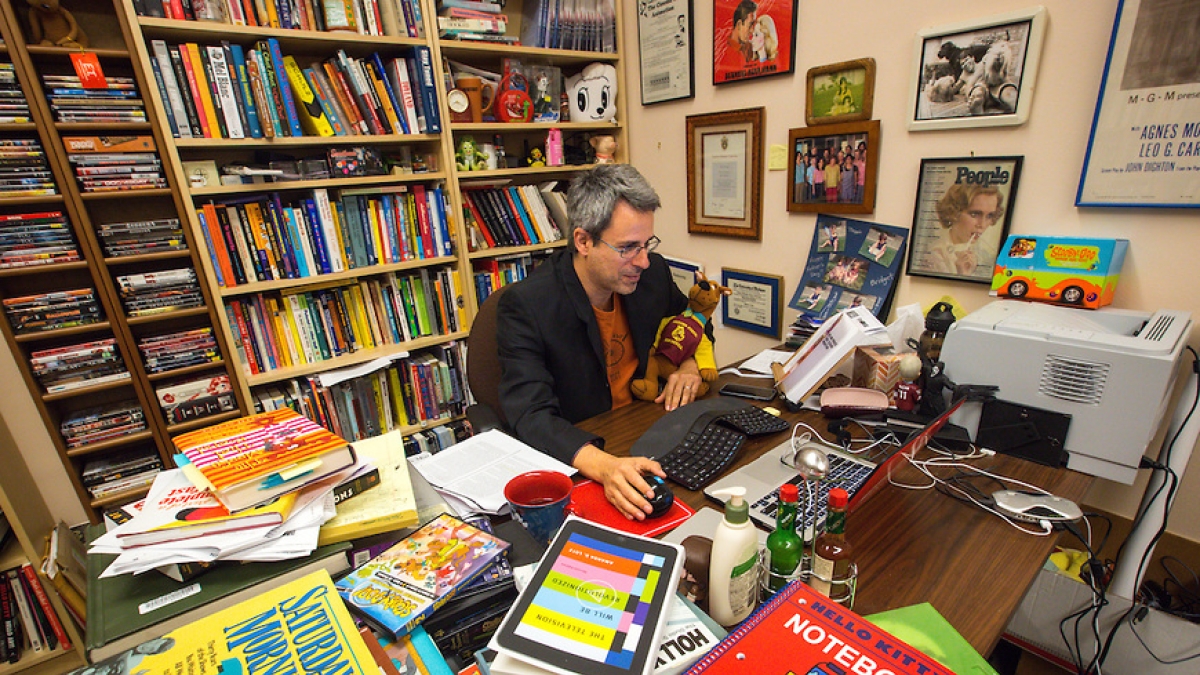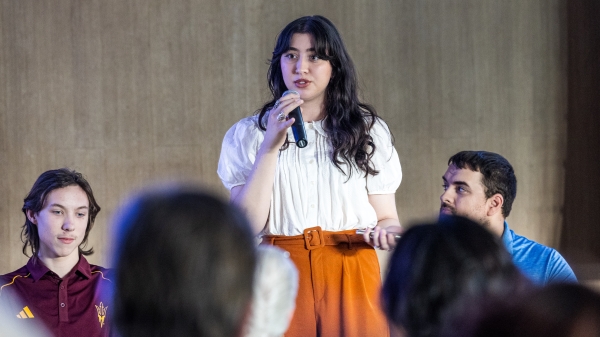Lecture to ask 'Scrappy-Doo, Where Are You?'
ASU director of film and media studies to put the rise and fall of Scrappy-Doo in a larger cultural and historical context

Kevin Sandler, a specialist in the contemporary U.S. media business and associate professor and director of film and media studies in the ASU Department of English, will put the rise and fall of Scrappy-Doo in a larger cultural and historical context in the next College of Integrative Sciences and Arts Humanities Lecture on Nov. 16 at ASU's Downtown Phoenix campus. Photo by Charlie Leight/ASU Now
Scooby-Doo, the animated character and series launched by Hanna-Barbera Productions in 1969, is one of the most successful brands in entertainment history. Nearly 50 years out, fans today can not only stream new and classic episodes, but can buy anything from Scooby-Doo games, books and DVDs, to Scooby-themed fruit snacks, underwear and pajamas.
“Scooby-Doo’s popularity all these years across so many entertainment platforms has made the series a shared reference point for many generations,” observed Arizona State University Associate Professor Kevin Sandler, a specialist in the contemporary U.S. media business.
Speaking of generations: Whatever became of Scooby’s feisty little nephew Scrappy-Doo, introduced in 1979?
That’s the mystery Sandler will focus on when he presents the final session of the fall 2017 Humanities Lecture Series of the College of Integrative Sciences and Arts at ASU’s Downtown Phoenix campus on Thursday, Nov. 16, in a talk titled "Scrappy-Doo, Where Are You? The Corporate Construction and Confinement of Scooby-Doo’s Annoying Nephew."
“Do an internet search on the phrase ‘most-annoying television characters of all time’ and you’re likely to find Scrappy-Doo on every list that comes up,” Sandler said. “He’s right up there with cousin Oliver from 'The Brady Bunch'!”
How and why did Scrappy-Doo come to exist in the first place? And why the hatred?
“Scrappy-Doo was very popular from the late ’70s to the mid-’80s, but over time he became the object of scorn. He eventually become persona non grata at Time Warner, where the catchphrase became ‘Scrappy is crappy,’” explained Sandler, who will share his research on the business decisions that brought the cartoon character Scrappy-Doo to life — and the resulting fallout from those decisions.
“If Scrappy shows up as a character anymore, it’s only if someone wants to kill him, or he’s depicted as a relic in a museum, or talked about in the most hateful way,” he said. “My job is to place Scrappy-Doo’s rise and fall in a larger cultural and institutional context.”
Sandler is associate professor and director in the Department of English’s Film and Media Studies Program in ASU’s College of Liberal Arts and Sciences. His scholarship has focused on censorship, convergence and animation.
He is the author of “The Naked Truth: Why Hollywood Doesn't Make X-Rated Movies,” the co-editor of “Titanic: Anatomy of a Blockbuster” and editor of “Reading the Rabbit: Explorations in Warner Bros. Animation.” He also has published widely in anthologies and journals; contributes frequently to podcasts, blogs and other online media; and is frequently asked to provide expert commentary on Hollywood and television history and popular culture.
Sandler earned a doctorate in film studies from Sheffield Hallam University in England. He holds a master’s degree in radio/TV/film from Indiana State University and a bachelor’s in communication from the University of Michigan.
'Scrappy-Doo, Where Are You? The Corporate Construction and Confinement of Scooby-Doo’s Annoying Nephew'
What: Final session of the fall 2017 Humanities Lecture Series of the College of Integrative Sciences and Arts.
When: 6:30 p.m. Thursday, Nov. 16.
Where: Cronkite School, room 128, Downtown Phoenix campus.
Details: Free and open to the public. Scooby Snacks may or may not be served.
More Arts, humanities and education

Students host gun culture storytelling event with an intergenerational audience
According to Bobbie Reed — a resident of Arizona State University's senior living retirement community center, Mirabella — guns…

ASU Gammage program brings the arts to incarcerated women
Laughter might not be the first thing you expect to hear when arriving at Maricopa County Estrella Jail, the all-women prison…

Maryvale girls gain confidence through volleyball program
Life as a teen or tween can be tough, particularly for girls. That's why an Arizona State University partnership with a…